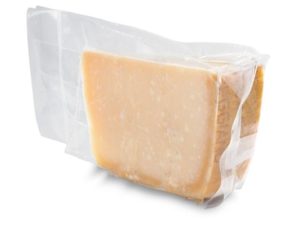Picture this: Three years from now, you open the fridge and unwrap a package of string cheese. You eat it. It tastes better, somehow, than the ones you ate as a kid.
Then you eat the packaging. And your body thanks you for it.
That’s the near-future envisioned by researchers at the US Department of Agriculture who are developing environmentally friendly food packaging made from milk protein, the American Chemical Society announced recently.
The material could replace the thin plastic film now stretched around blocks of cheese, packages of steaks and other foods at your supermarket. The kicker: This protein-based packaging isn’t just biodegradable and edible – it keeps food fresher than plastic, too.
The film’s protein, casein, bonds tightly, creating a packaging that’s up to 500 times more effective than plastics at keeping oxygen away from food, researchers said. That means the packaging is better for the earth and better for your food, and it can be eaten, they said.
Dr. Laetitia Bonnaillie, a co-leader of the study, expects to see the casein packaging hit store shelves within three years.

“The coatings applications for this product are endless,” Bonnaillie said. “We are currently testing applications such as single-serve, edible food wrappers. For instance, individually wrapped cheese sticks use a large proportion of plastic. We would like to fix that.”
The film could also wrap servings of coffee, melting away in the brewing process and adding protein, too. It could encase packs of ramen noodles, letting college kids simply plop them in a pot of boiled water. Sprayed onto breakfast cereal, the protein coating could also keep cornflakes from getting soggy — a dilemma cereal companies currently use sugar coatings to solve.
The film has little taste, researchers said. Flavours and vitamins could be added to the packaging, they noted.
To keep the packaging clean and dry for consumption, products using them would need to be shipped, shelved and sold in external containers made of plastic or cardboard — the same kind of secondary packaging many single-serve products already use.
And while some starch-based edible packaging has already hit the market, the casein-based film’s smaller pores prove more effective at keeping oxygen out.
The researchers were invited to present their research at the American Chemical Society’s national meeting.

You must be logged in to post a comment Login